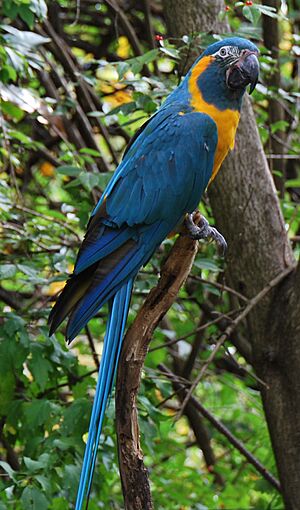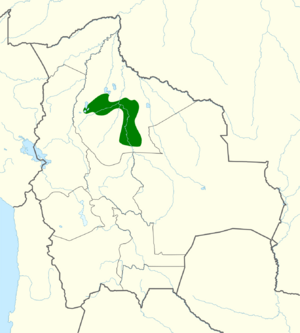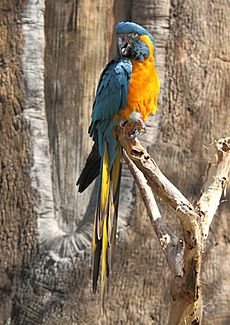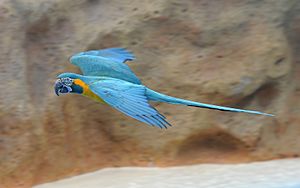Blue-throated macaw facts for kids
Quick facts for kids Blue-throated macaw |
|
|---|---|
 |
|
| At Cincinnati Zoo and Botanical Garden, Ohio, USA | |
| Conservation status | |
| Scientific classification | |
| Genus: |
Ara
|
| Species: |
glaucogularis
|
 |
|
| Distribution range | |
| Synonyms | |
|
|
The blue-throated macaw (Ara glaucogularis) is a beautiful parrot. It is also called the Caninde macaw or Wagler's macaw. This special bird lives only in a small part of north-central Bolivia, an area known as Los Llanos de Moxos. In 2014, Bolivia declared this macaw a national treasure.
Sadly, the blue-throated macaw is now Critically Endangered. This means it is very close to disappearing from the wild forever. Only about 208–303 adult birds are left. Many things have caused this decline. In the past, local people hunted them for their feathers. They used the feathers to make special headdresses for traditional dances. Also, these macaws faced problems like other birds competing for their nests and predators.
Today, the main threats are still hunting and trapping. Cutting down trees, new species moving into their habitat, and diseases also harm them. The IUCN lists it as Critically Endangered. It is also protected by rules that stop people from trading these birds. The name "Wagler's macaw" honors a German scientist named Johann Georg Wagler, who first described these blue macaws to people in Europe.
Contents
Understanding the Blue-throated Macaw
What is a Blue-throated Macaw?
The scientific name for the blue-throated macaw is Ara glaucogularis. The word Ara comes from a Tupi Indian word for macaw. Glauco means grayish-blue or green, and gularis means throat. So, its name describes its blue throat!
This macaw is one of eight types of large, long-tailed parrots in the Ara group. All these birds are called macaws. The Ara group is part of a bigger family of parrots that live in Central and South America. Scientists once thought the blue-throated macaw was just a type of the similar-looking blue-and-yellow macaw.
How Does the Blue-throated Macaw Look?

The blue-throated macaw is about 85 centimeters (about 33 inches) long. This includes its long tail feathers. Its wings can spread up to 90 centimeters (about 3 feet) wide. It weighs about 900 to 1100 grams (about 2 to 2.4 pounds). Male macaws are usually a little bigger than females.
Its upper body is turquoise-blue, which is brighter on its back. Its belly is bright yellow, but its bottom is light blue. It has a bare patch of skin on its face. This skin has unique blue feather lines that are different for each macaw. These lines can help identify individual birds.
Young macaws have brown eyes. As they grow, their eyes change color. They turn grey, then white, and finally yellow when they are adults. Very old macaws might have a dark grey ring around their pupils. You can tell a blue-throated macaw from a blue-and-yellow macaw by its blue throat and blue head. The blue-and-yellow macaw has a black throat and a green head.
Where Do Blue-throated Macaws Live?
The blue-throated macaw lives in the Llano de Moxos area of Bolivia. This area is in the Beni Department. They do not live in thick forests. Instead, they live in open plains with "islands" of palm trees. These palm tree islands are where they build their nests.
This species is one of the rarest birds in the world. There are two main groups of these macaws. One group lives northwest of Trinidad, the capital city of Beni. The other group lives south of Trinidad. Their home is a mix of grasslands, wet areas, forest islands, and forests along rivers. They usually live at heights between 200 and 300 meters (about 650 to 980 feet).
Blue-throated Macaw Behavior
How Do Blue-throated Macaws Live?
Blue-throated macaws are usually found in pairs. They stay with one mate for life. Sometimes, small groups of 7 to 9 birds are seen. There is even one large group of 70 birds known to roost together. We don't know if they find a new mate if their first one dies.
These birds mostly fly to get around. But they can also climb trees, move along branches, and walk on the ground. They are active during the day and usually stay in one area. Blue-throated macaws talk to each other mostly with sounds. If they sense danger, they make a very loud alarm call and fly away quickly. They also use quiet calls to communicate.
What Do Blue-throated Macaws Eat?
Unlike many other macaws, blue-throated macaws do not eat many seeds and nuts. Their main food is fruit from large palm trees. They especially love the fruit from the Attalea phalerata palm. They also eat fruit from Acrocomia aculeata and Mauritia flexuosa palms. The macaws eat the fleshy part of ripe and almost ripe fruit. They have also been seen drinking the liquid from very young fruit.
How Do Blue-throated Macaws Raise Their Young?
Blue-throated macaws usually breed once a year. If their eggs or babies are lost, they might lay a second set of eggs in the same year. A female macaw lays one to three eggs. The eggs hatch after about 26 days. Baby macaws weigh about 18 grams (0.6 ounces) when they hatch. They leave the nest when they are 13 to 14 weeks old.
Even after leaving the nest, young macaws still need their parents for food. They stay with their parents for up to a year. During this time, the parents will not breed again. Blue-throated macaws become old enough to have their own babies when they are about 5 years old.
Where Do Blue-throated Macaws Nest?
Blue-throated macaws usually nest in holes inside palm trees. They prefer dead palm trees, especially the Attalea phalerata palm. This is because large grubs hollow out these dead trees, making perfect nesting spots. Macaw pairs do not always use the same nest every year. They usually look for new nesting places each breeding season.
In the wild, blue-throated macaws often have to compete for nesting holes. Other birds like the blue-and-yellow macaw, green-winged macaw, scarlet macaw, woodpeckers, and toco toucans also want these spots. Even barn owls, bats, and bees compete for nests. Sadly, there are fewer good nest trees now. This is because many trees are being cut down in their natural home.
Protecting the Blue-throated Macaw
What is Being Done to Help Them?
The blue-throated macaw population is very small. It is critically endangered, meaning it faces a very high risk of extinction. It is also protected by CITES, which controls international trade of endangered species. In Bolivia, it is illegal to trap these macaws.
In the 1980s, people thought there were about 500-1000 blue-throated macaws in the wild. Even though trapping stopped in the 1990s, the number of birds stayed low. Recent surveys have found more birds, bringing the estimate to about 350–400.
Many groups are working to save these birds. The World Parrot Trust has volunteers who watch nests to protect the chicks from predators. They also check the chicks to make sure they are healthy and getting enough food. If a chick needs more food, they give it special formula. People are also building new nest boxes and improving old ones. Local landowners are helping too.
In 2008, several groups created the blue-throated macaw Reserve. This reserve protects the birds' habitat. In 2010, the reserve grew to 11,500 acres. This gives the macaws more safe space to live.
Another great program helps local people. It replaces real feathers in traditional headdresses with fake ones made from painted palm leaves. In the past, many macaws were killed for their feathers to make these headdresses. This new program helps protect the birds while still allowing cultural traditions.
Blue-throated Macaws as Pets
Blue-throated macaws are sometimes kept as pets. There are about 1000–1100 of them in zoos and private homes around the world. They can be found in zoos like the Santa Cruz zoo in Bolivia. In captivity, blue-throated macaws have sometimes bred with military macaws, creating a mixed type called Corrientes macaws.
Zoos and conservation groups have started breeding programs to help save this species. Other projects are working to protect the wild birds.
In the wild, blue-throated macaws often nest earlier than other macaws. This means they get the best nesting holes in dead palm trees first. Sometimes, parents will keep feeding their third chick less. This is like an "insurance policy." If the older, stronger chicks don't survive, the parents can then focus on feeding the youngest one. This helps researchers raise the third chick in captivity and then return it to the wild when it's almost ready to fly.
When tame, blue-throated macaws can be friendly and loving pets. They are smart birds. Like most parrots, they need many hours outside their cage each day. They also need to interact with humans or other birds to stay healthy. They are known for being able to damage things and escape from their cages if left alone. They might be less noisy than other large macaws and can sometimes learn to say a few words. The World Parrot Trust suggests that these macaws should live in very large enclosures, at least 15 meters (about 50 feet) long. They can live for over 50 years in captivity.
Plumage details
See also
 In Spanish: Guacamayo barba azul para niños
In Spanish: Guacamayo barba azul para niños







